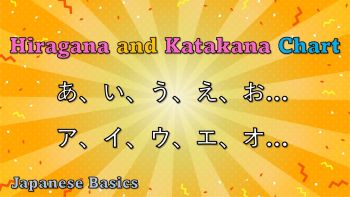The modern hiragana and katakana chart is called「五十音 (gojūon)」.
Hiragana and Katakana Chart

| あ-column | い-column | う-column | え-column | お-column | |
| あ-row | あ ア a | い イ i | う ウ u | え エ e | お オ o |
| か-row | か カ ka | き キ ki | く ク ku | け ケ ke | こ コ ko |
| さ-row | さ サ sa | し シ shi | す ス su | せ セ se | そ ソ so |
| た-row | た タ ta | ち チ chi | つ ツ tsu | て テ te | と ト to |
| な-row | な ナ na | に ニ ni | ぬ ヌ nu | ね ネ ne | の ノ no |
| は-row | は ハ ha | ひ ヒ hi | ふ フ fu/hu | へ ヘ he | ほ ホ ho |
| ま-row | ま マ ma | み ミ mi | む ム mu | め メ me | も モ mo |
| や-row | や ヤ ya | ゆ ユ yu | よ ヨ yo | ||
| ら-row | ら ラ ra | り リ ri | る ル ru | れ レ re | ろ ロ ro |
| わ-row | わ ワ wa | を ヲ o | |||
| ん ン n |
These 46 characters are used in modern Japan.「五十」means “fifty”,「音」means “sound.” Long ago, Japanese people used 50 hiragana characters.
Please learn hiragana and katakana basics and the pronunciation through this video.
Watch other Videos on YouTube: Here
Dakuon and Handakuon Charts
濁音 (だくおん、Dakuon)
Dakuon means “murky sound” when literally translated from Japanese.
Dakuon is indicated by two small dots. The dots are called「濁点(dakuten)」.
| あ-column | い-column | う-column | え-column | お-column | |
| が-row | が ガ ga | ぎ ギ gi | ぐ グ gu | げ ゲ ge | ご ゴ go |
| ざ-row | ざ ザ za | じ ジ ji | ず ズ zu | ぜ ゼ ze | ぞ ゾ zo |
| だ-row | だ ダ da | ぢ ヂ ji | づ ヅ zu | で デ de | ど ド do |
| ば-row | ば バ ba | び ビ bi | ぶ ブ bu | べ ベ be | ぼ ボ bo |
The pronunciation of「ず(ズ)」and「づ(ヅ)」are the same. The pronunciation of「じ(ジ)」and「ぢ(ヂ)」are also the same.
半濁音 (はんだくおん、Handakuon)
Handakuon literally means “half-murky sound” when literally translated from Japanese. Handakuon is indicated by a small circle. The circle is called「半濁点 (handakuten)」.
| あ-column | い-column | う-column | え-column | お-column | |
| ぱ-row | ぱ パ pa | ぴ ピ pi | ぷ プ pu | ぺ ペ pe | ぽ ポ po |
You can learn the pronunciations through the attached video “Hiragana and Katakana | Learning Japanese Basics for Beginners.”


